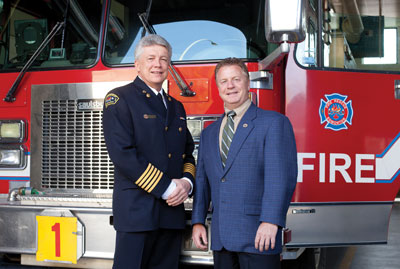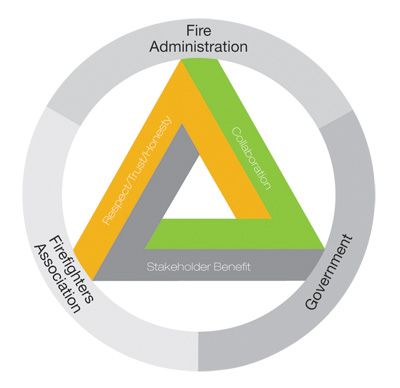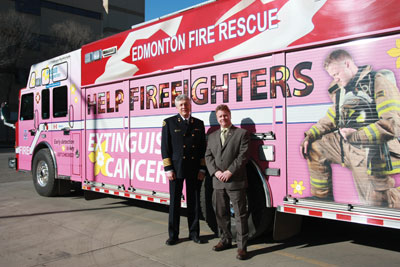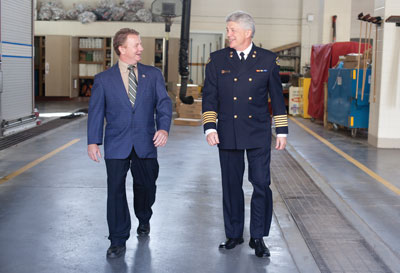
Features
Hot topics
Labour relations
Labour relations 101
Labour relations in Canada’s fire departments are iffy at best.
June 11, 2012
By Jay Shaw and Laura King
Labour relations in Canada’s fire departments are iffy at best.
 |
|
| Edmonton Fire Chief Ken Block and association president Greg Holubowich have a longstanding co-operative relationship that has benefited all fire-service stakeholders. Photo by Jason Franson |
In Corner Brook, N.L., the union secured a 16 per cent raise (over four years) in February. Immediately after signing the contract, the city laid off four firefighters.
In Brandon, Man., union president Wade Ritchie was suspended, demoted, fired and re-hired between January and May. Fire Chief Brent Dane – a former union president – announced a settlement of all issues before the Manitoba Labour Board in mid-May, on the same day he was to testify at an arbitration hearing into unfair labour practices.
In Ajax, Ont., the 24-hour shift has divided labour and management, and departments are watching for the outcome of an arbitration hearing on the issue.
Chiefs in many departments feel embattled as municipal councils trim fire budgets and firefighter associations press for wages, gear, training and benefits.
All this strife flies in the face of the healthy and robust labour-management relationship in Edmonton, where Fire Chief Ken Block – also a former union president – and Edmonton Fire Fighters Union (EFFU) president Greg Holubowich have built a strong, harmonious partnership based on trust and common goals.
 |
|
| Each side of the triangle represents a collaborative path among fire service administration, the union, and government. Each side must be seen as an equal partner. The relationships are tri-lateral, meaning each side can go to, or through, the other to achieve a desired outcome. Transparency is a must.
|
“In Edmonton we lived the worst-case scenario from 1987 to 2001, when union and administration were at war,” Block says. “There was no trust, no respect, and each had their own agendas. Our job was torn apart and the fire service suffered greatly. There was a lack of effective leadership on either side with much focus centred on undermining the other’s credibility.
“We learned that in order to move forward we had to have credible people in place, identify areas where we could work together, and then build the trust and respect necessary with one another’s constituents to allow us to work together on common issues.”
The story of Edmonton Fire Rescue Service’s (EFRS) journey to labour-relations harmony is complex but the foundations are simple: co-operation, planning, communication, buy-in, and, essentially, consistently playing nicely with others.
From an outsider’s perspective, Edmonton’s union and fire-service administration have pioneered a friendly, new union-management ideology that leverages each other’s strengths to meet everyone’s needs and wants – a collaborative-management triangle, so to speak.
To complete the triangle, the third party – government, all levels – is a necessary and powerful partner that fire departments need to win over and, in some cases, support, in order to achieve their goals. Firefighter associations have become extremely adept at working with government. Harnessing this energy and political astuteness is a strategy that fire departments should embrace to further their agendas and move their initiatives forward.
* * *
Chief Block was president of the Edmonton Fire Fighters Union from 2001 until 2007.
Holubowich, the current president, is a 21-year firefighter and has been involved with the union for 12 years, six as president.
If there’s one lesson that’s clear from EFRS’s experience, it’s that unions and management understanding each other’s motivations is the most powerful tool departments can use to meet their needs, build new programs and resources, and work with government to affect policy change.
In the last decade, fire unions have evolved from local organizations into political machines capable of organizing, fundraising, marketing and mastering everything from boot drives to election campaigns. Some unions are so powerful they have become political entities themselves, delving into issues that are indirectly related to the fire service but crucially important to the political parties they support.
 |
|
| Edmonton Fire Chief Ken Block started laying groundwork for a strong relationship with the firefighters association back when he was union president from 2001 through 2007. Today, Block and union president Greg Holubowich have a transparent and mutually beneficial working relationship. Photo courtesy Edmonton Fire Rescue Services
|
The International Association of Firefighter (IAFF) declares on its website that “The goal of any politician, after having been elected, is to get reelected.” For politicians to do what they promise their constituents, they must remain in office. Lobbying for politicians and helping them win is a powerful tool; those who master this can effectively control, to a degree, the outcome of what used to be uncontrollable circumstances – things like fire-department funding, or legislation on everything from sprinklers to line of duty deaths. Fire unions have always dabbled in the political arena, but only recently have they learned to master the rules and control their destinies by choosing and supporting those who support their own ideologies. The mandate of the IAFF is to support those who support it.
There’s not enough space here to argue the ethics of these political relationships. Fire unions did not create this political process, but they have gained exceptional expertise in leveraging its power. Harnessing the energy and passion of politically active unions allows fire departments to work with government to create mutually beneficial initiatives for firefighters, management and taxpayers. Understanding your region’s political leanings is crucial. In Manitoba the collaborative-management triangle includes a strong working relationship with a conservative mayor and a left-of-centre premier. In Alberta, the triangle focuses on civic politicians, and in Ontario, the Liberal premier is the target of the union’s attention.
Chief Block cites a simple example of how the triangle works.
When Block stepped down as union president in 2007, the fire chief of the day was determined to win a budget increase for more fire-prevention officers. Holubowich – the new union president, and his executive – believed that additional firefighters to staff a new rescue truck were more important, and the union made its preference known to council.
“The result was not surprising,” Block says, “and in a very difficult budget year, council seized on the difference in priorities and didn’t fund either.”
That story, Block says, shows the importance of being transparent with labour, including the union executive in difficult discussions such as budget priorities, and making an effort to appreciate the union’s priorities and challenges.
“These discussions and information sharing are critical to progress being possible,” Block says.
As chief, Block says he reflects on his positive experiences as union president to acknowledge and use the power of the union.
“I absolutely view the position of union president to be an equivalent – albeit reporting to different stakeholders and constituents – to the position of the fire chief. Each has powers and abilities to influence key constituents that the other does not.
“Those differences, when used constructively, can be of great assistance to ensuring the success of both the union and the fire service and, conversely, those differences can be used to advance and entrench agendas that are destructive to both the union and the fire service.”
Block notes that after he became chief, one of the first things he and Holubowich agreed on was the need for more firefighters to staff a rescue truck.
“It will come as no surprise that council heard clearly that both administration and union were aligned with this budget priority and the new funding for the additional 20 positions was approved,” Block says.
“The value of our administration and union working together cannot be overstated.”
* * *
When Block was first promoted to chief, he had seen enough negativity to last a lifetime and wanted to install a new system that defined how he would lead. The system included several initiatives – some new, some that had already been implemented.
“My first priority as the new fire chief in 2009 was to establish the principles or cornerstones of my administration,” Block says.
Those principles are public service, safety, public trust and support, and teamwork.
“Our principles were developed in conjunction with our union executive and my administration team,” Block says.
 |
|
| Including the union in key decisions such as budget discussions and outlining the department’s principles and visions have helped to strengthen the management-union relationship in Edmonton. Photo by Jason Franson
|
“It was imperative to our success that the principle officers of our bargaining unit, as well as my deputies, understood what each principle was about, and the thought process and rationale that was behind them. After some great conversations and input from all, the principles were accepted unanimously and we were able to roll them out to our Fire Rescue staff in all areas.”
Long before the four cornerstones were developed, Block, as union president, had worked with former Fire Chief Randy Wolsey on the creation of an EFRS master plan, which outlines the department’s goals.
“[Wolsey] believed that the days of a budget presentation that was based on anecdotal information to council having any chance of success had passed,” Block said.
“What the fire service needed to assist building a proper business case for budget requests was a master plan outlining goals and objectives that were supported by performance measures consistent with recognized fire-service standards; these had to align with council’s strategic, long-range planning.”
The plan includes performance measures that serve as benchmarks for EFRS.
After Block became chief, EFRS went a step further and developed a program to achieve accreditation through the Center for Public Safety Excellence, Commission of Fire Accreditation International (CFAI). Essentially, the accreditation process is an independent audit of every aspect of operations.
“This process,” Block says, “validates that our master plan principles and objectives are based on legitimate, industry-accepted standards that are supported by our citizens, our elected officials, and by those incredible men and women who comprise our fire rescue service.”
On March 9, 2010, EFRS was recognized by CFAI and achieved full agency accreditation.
Another document that has helped union and management understand each other’s positions is the city’s working-relationship agreement with all civic unions.
“The WRA has been one of the foundations used in developing our labour-management relationship with EFRS administration,” Holubowich says. “This WRA sets a tone of behaviour and conduct expected by all department and union leaders to basically respect each other.”
* * *
So, what has changed? Morale, for one.
“At the depths of the dark days, there was no labour-management relationship, no trust,” Block says. “Both sides were positional and the time and energy of both sides was spent exclusively on efforts aimed at discrediting and undermining one another and the influence they had on their constituents.”
Block offers another anecdote.
“The fire administration implemented a system of rotating days off in lieu of stat pay, whereby members would be sent home without notice for an entire shift. The union responded by implementing a straight up and down relief, whereby firefighters wouldn’t relieve their man until exactly 08:00 and 18:00 hours, which resulted in administration having difficulty managing staffing in stations without incurring significant overtime.
“Firefighters began booking off sick often and for several shifts at a time. The fallout from these tactics on both sides was an unacceptable level of short-term sick leave and long-term sick leave and extensive overtime. There were 84 grievances on the books by 1995 and the management style was to ignore the collective agreement and tell the union to grieve if they didn’t like it, and then ignore the grievance procedure.
“At the end of the day, it tore the department apart. The service to the public suffered, there was little to no training being done, and firefighters felt under appreciated by administration.”
Today, a comparison of sick leave numbers tells the story. Between 1990 and 2001, before Block was union president, an average of 25 to 30 firefighters a day (out of a total of 764) were on short- or long-term sick leave, in addition to 25 to 30 firefighters off on long-term disability at any given time. Now, with 1,115 firefighters on staff, the daily average for short-tem leave is between 10 and 15 firefighters; the daily average for long-term leave is eight to 10.
The numbers show a 50 per cent reduction in sick time and a saving of about $600,000 yearly since 2008. While there are still grievances, they are the exception, and Block can recall just once during his tenure when there have been two at once. As Holubowich explains, the positive working relationship has led to forward-thinking initiatives and co-operation on big-picture projects.
“We worked together in the development and introduction of a health and wellness program that is non-punitive and voluntary,” he says.
“We have an amazing 80 per cent participation rate that has pre-screened in early stages some very serious medical issues that our members did not know they had. The program saves lives and is only here because we work together with the government and our fire administration. The $600,000 per year to fund this program would never have happened with poor relations.”
Of note is the fact that the $600,000 for the fitness-wellness initiative came from council and was initially approved after a presentation by the union.
Holubowich has made sure his members understand how the relationship among union, management and government has paid off.
“We believe our union members are the greatest assets of this public safety organization [EFRS],” Holubowich says.
“What better group to access than the union, which represents the workers and has a thorough knowledge of not only the work they do but also the collective agreements that governs the workforce. If there needs to be an adjustment or amendment to a collective agreement, the union can be part of the discussions from the start and this allows a greater opportunity for buy-in. By working together in developing strategic plans the people of influence (government), they see that there is a greater chance of success and are more apt to approve the plans put before them.”
Without spending money on lawyers or focusing on negativity, union and administration have collectively saved hundreds of thousands of dollars that have been redirected to support various positive initiatives. In addition, the union no longer leases office space but owns a building and rents space to tenants, which creates income for the association.
Holubowich says the union’s focus is absolute and defined.
“We have been able to channel our efforts on providing better service to our members and have built better relations throughout the fire industry,” he says. “Our union dues have been the same for 10 years and we continue to try to improve our service to our members all the time.”
Is there a message for the fire service about how to orchestrate such a huge attitude shift?
“A labour/management relationship that is progressive and collaborative requires significant dedication and work by all involved,” Block says.
“You have to go back to that cornerstone document and really try to use it as a tool. Success does not come without tremendous challenges and risk, and once achieved it can never be taken for granted, as there are always those who might want to go in a different direction.”
Print this page